#414 Squadron (Totus Viribus) RCAF Station Bagotville. Canadair Sabre aircraft 19660 crashed at St Charles Borromee, Quebec, Canada
Pilot Flying Officer GC Hall (RCAF) was killed in this flying accident


Birth Date: 1930-February-25
Born: Stettler, Wainwright Census Division, Alberta, Canada
Parents: Son of Gordon and Clara of Lac la Biche, Alberta
Spouse: Husband of Alice Hall. Father of Marguerite Hall. Brother of Dorothy.
Home: Lac la Biche, Alberta
Enlistment: Edmonton, Alberta
Enlistment Date: 1951-July-12
Service
RCAF
Unit
414 Sqn- Squadron
Totis Viribus With All our Might
Base
Bagotville, Quebec, Canada
Rank
Flying Officer
Position
Pilot
Service Numbers
41385
#414 Squadron (Totus Viribus) RCAF Station Bagotville. Canadair Sabre aircraft 19660 crashed at St Charles Borromee, Quebec, Canada
Pilot Flying Officer GC Hall (RCAF) was killed in this flying accident
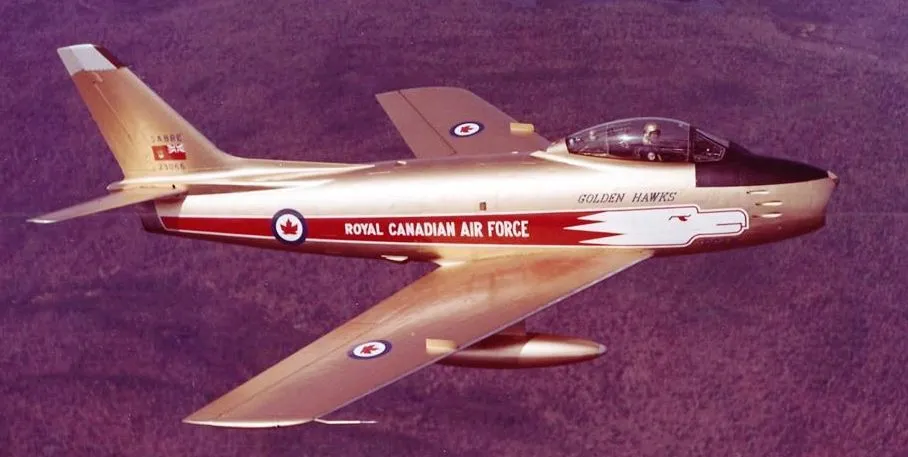
The North American F-86 Sabre, sometimes called the Sabrejet, is a transonic jet fighter aircraft. Produced by North American Aviation, the Sabre is best known as the United States' first swept-wing fighter that could counter the swept-wing Soviet MiG-15 in high-speed dogfights in the skies of the Korean War (1950"“1953), fighting some of the earliest jet-to-jet battles in history. Considered one of the best and most important fighter aircraft in that war, the F-86 is also rated highly in comparison with fighters of other eras. Although it was developed in the late 1940s and was outdated by the end of the 1950s, the Sabre proved versatile and adaptable and continued as a front-line fighter in numerous air forces.
Its success led to an extended production run of more than 7,800 aircraft between 1949 and 1956, in the United States, Japan, and Italy. In addition, 738 carrier-modified versions were purchased by the US Navy as FJ-2s and -3s. Variants were built in Canada and Australia. The Canadair Sabre added another 1,815 aircraft and the significantly redesigned CAC Sabre (sometimes known as the Avon Sabre or CAC CA-27), had a production run of 112. The Sabre is by far the most-produced Western jet fighter, with a total production of all variants at 9,860 units.
The fighter-bomber version (F-86H) could carry up to 2,000 lb (907 kg) of bombs, including an external fuel-type tank that could carry napalm. Unguided 2.75-inch (70-millimeter) rockets were used on some fighters on training missions, but 5-inch (127 mm) rockets were later carried on combat operations. The F-86 could also be fitted with a pair of external jettisonable jet fuel tanks (four on the F-86F beginning in 1953) that extended the range of the aircraft. Both the interceptor and fighter-bomber versions carried six 0.50 in (12.7 mm) M3 Browning machine guns with electrically-boosted feed in the nose (later versions of the F-86H carried four 20 mm (0.79 in) cannon instead of machine guns). Firing at a rate of 1,200 rounds per minute, the 0.50-inch guns were harmonized to converge at 1,000 ft (300 m) in front of the aircraft, using armor-piercing (AP) and armor-piercing incendiary (API) rounds, with one armor-piercing incendiary tracer (APIT) for every five AP or API rounds. The API rounds used during the Korean War contained magnesium, which were designed to ignite upon impact, but burned poorly above 35,000 ft (11,000 m) as oxygen levels were insufficient to sustain combustion at that height. Initial planes were fitted with the Mark 18 manual-ranging computing gun sight. The last 24 F-86A-5-Nas and F-86Es were equipped with the A-1CM gunsight-AN/APG-30 radar, which used radar to automatically compute a target's range, which later proved to be advantageous against MiG opponents over Korea. Wikipedia
![]() Wikipedia North American F-86 Sabre
Wikipedia North American F-86 Sabre
![]() YouTube F-86 Sabre Aerobatics - No Music! - Airshow London 2018
YouTube F-86 Sabre Aerobatics - No Music! - Airshow London 2018
F-86 (Canadair Sabre) Part Manual Volume I
F-86 (Canadair Sabre) Part Manual Volume II
F-86 (Canadair Sabre) Maintenance and Diagrams (Partial Document)
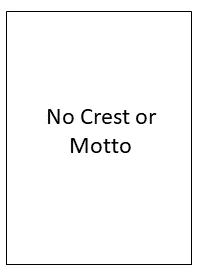
Note that during WWII the squadron had no crest nor motto. These were awarded later. The squadron was unofficially known as the “Sarnia Imperialsâ€.
No. 414 Squadron was formed as the RCAF's 12th squadron formed overseas in WWII, at Croydon, Surrey, UK ![]() . It was the second Army Co-operation unit to be formed in this group, and was initiated on 13 August 1941. In the early days, it flew Westland Lysander Mk. III aircraft before flying Curtiss Tomahawk Mks. I and II (both non-operationally). It saw no action in the AC role since no army units were active in Europe. On 28 June 1943 the unit was re-designated a Fighter Reconnaissance unit at Dunsfold, Surrey. Thereafter, the squadron joined the 2nd Tactical Air Force. By now it was flying North American Mustang Mk. I aircraft. The duties were to provide intelligence, such as photographic reconnaissance before and after D-Day, and tactical reconnaissance once the invasion had taken hold. The squadron was issued with Supermarine Spitfire aircraft and moved to France in August 1944, and thereafter followed the Allied armies in their progress through France, the Low Countries and Germany, providing reconnaissance for them. The squadron was disbanded at Luneburg, Germany
. It was the second Army Co-operation unit to be formed in this group, and was initiated on 13 August 1941. In the early days, it flew Westland Lysander Mk. III aircraft before flying Curtiss Tomahawk Mks. I and II (both non-operationally). It saw no action in the AC role since no army units were active in Europe. On 28 June 1943 the unit was re-designated a Fighter Reconnaissance unit at Dunsfold, Surrey. Thereafter, the squadron joined the 2nd Tactical Air Force. By now it was flying North American Mustang Mk. I aircraft. The duties were to provide intelligence, such as photographic reconnaissance before and after D-Day, and tactical reconnaissance once the invasion had taken hold. The squadron was issued with Supermarine Spitfire aircraft and moved to France in August 1944, and thereafter followed the Allied armies in their progress through France, the Low Countries and Germany, providing reconnaissance for them. The squadron was disbanded at Luneburg, Germany ![]() on August 7, 1945.
on August 7, 1945.
In the course of WWII the squadron flew over 6,000 sorties for the loss of 23 pilots, 19 of whom were killed or missing, the remaining 4 being POWs. They claimed 29 enemy aircraft destroyed, 1 probable and 11 damaged. On ground attack, they accounted for 76 locomotives and other miscellaneous targets. The squadron produced one ace, Flight Lieutenant D.I. Hall DFC. Awards gained were 2 Bars to DFC, 16 DFCs and 3 MiD. Battle Honours were:Defence of Britain 1942-43, Fortress Europe 1942-44, Dieppe, France and Germany 1944-45: Normandy 1944, Arnhem Rhine, Biscay 1943Wikipedia, Kostenuk and Griffin
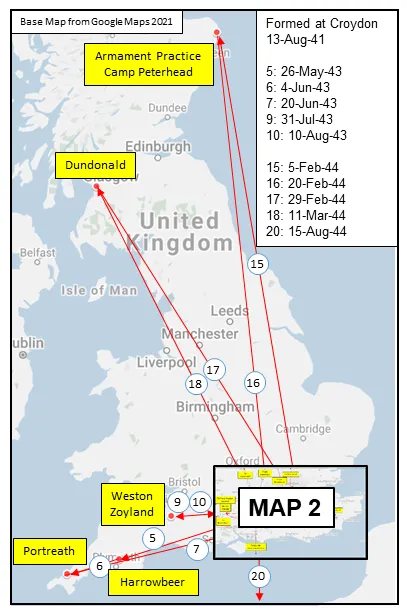
MAP 1: 414 Squadron Movements in Britain 1941-44 (right-click on image to display enlarged in new tab)
|
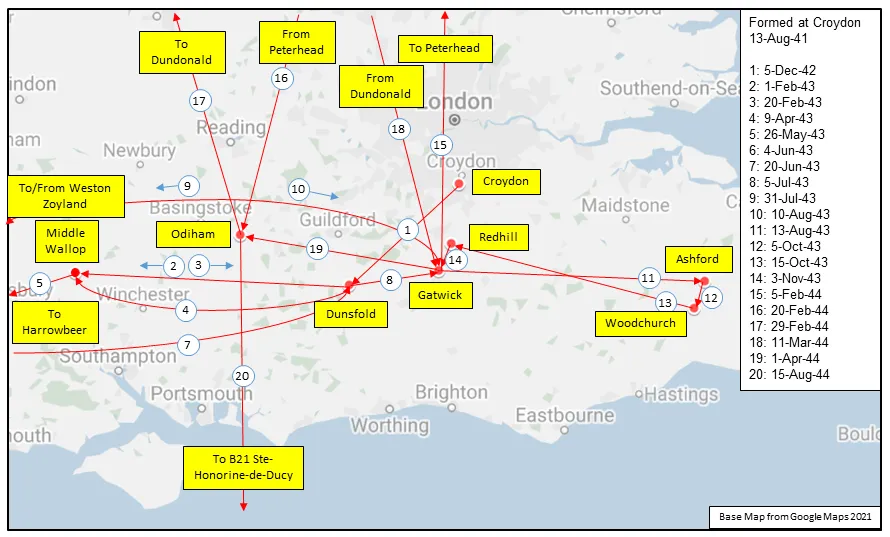
MAP 2: 414 Squadron Movements Detail of Map 1
|
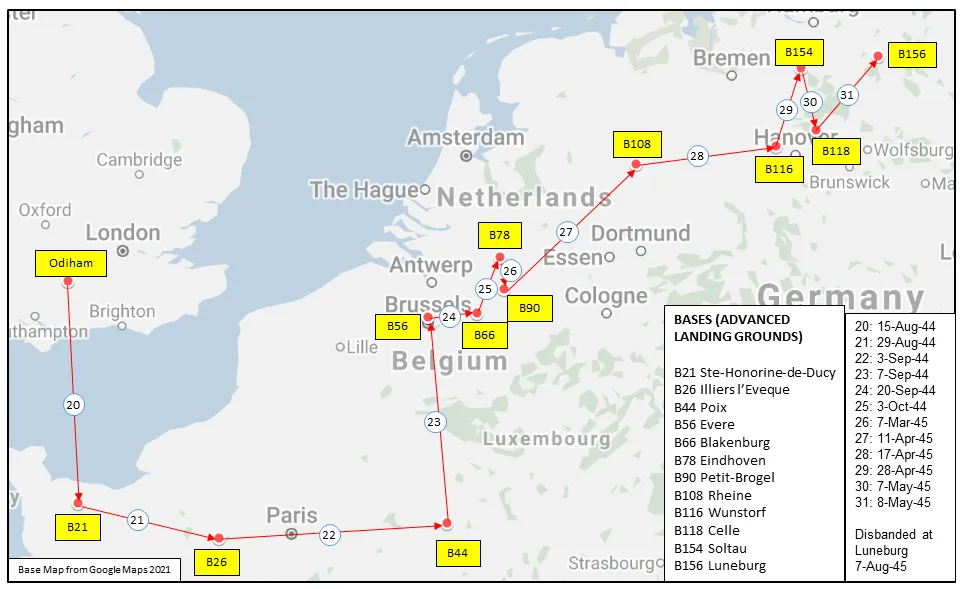
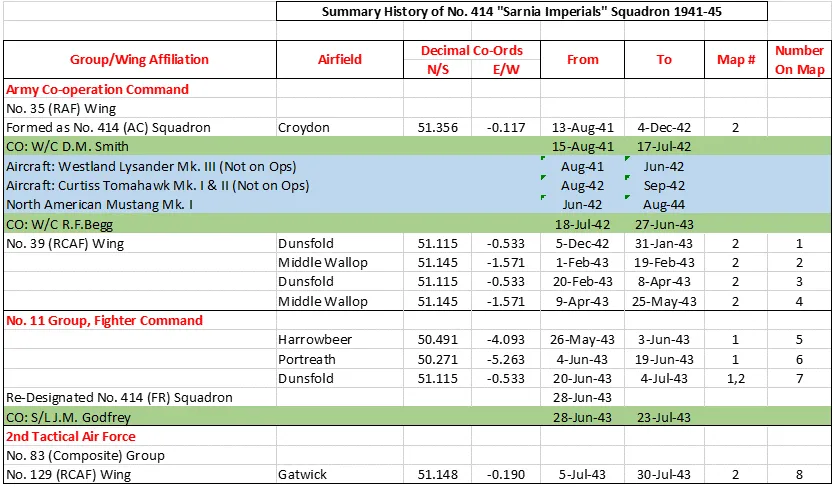


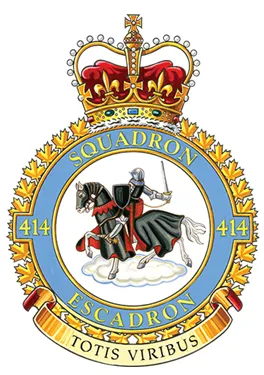
Unofficially, No. 14 (Photographic) Squadron at Rockcliffe (Ottawa), Ontario ![]() was formed on 12 June 1944, and it was officially renumbered No. 414 on 1 April 1947. The squadron flew Douglas Dakota IIP and IVP aircraft on vertical photographic duty, to photograph 323,754 square miles (838,520 km2) of Canada's North. When this task was completed the squadron was disbanded on 1 November 1950.
was formed on 12 June 1944, and it was officially renumbered No. 414 on 1 April 1947. The squadron flew Douglas Dakota IIP and IVP aircraft on vertical photographic duty, to photograph 323,754 square miles (838,520 km2) of Canada's North. When this task was completed the squadron was disbanded on 1 November 1950.
The squadron was re-formed as a Fighter unit at Bagotville, Quebec ![]() on 1 November 1952, equipped with Canadair Sabre aircraft. It later joined No. 4 (Fighter) Wing at Baden-Soellingen, Germany
on 1 November 1952, equipped with Canadair Sabre aircraft. It later joined No. 4 (Fighter) Wing at Baden-Soellingen, Germany ![]() in August 1953. In 1956, it was decided to replace one Sabre squadron in each of No. 1 Air Division Europe’s four wings with an all-weather fighter unit. When No. 419 AW(F) Squadron arrived from Canada, No. 414 was deactivated on 14 July 1957 and reactivated as All-Weather (Fighter) at North Bay, Ontario
in August 1953. In 1956, it was decided to replace one Sabre squadron in each of No. 1 Air Division Europe’s four wings with an all-weather fighter unit. When No. 419 AW(F) Squadron arrived from Canada, No. 414 was deactivated on 14 July 1957 and reactivated as All-Weather (Fighter) at North Bay, Ontario ![]() on 5 August 1957. The squadron flew CF-100 and CF-101 aircraft on North American air defence until disbanded on 30 June 1964.
on 5 August 1957. The squadron flew CF-100 and CF-101 aircraft on North American air defence until disbanded on 30 June 1964.
The squadron re-formed once again at RCAF Station St-Hubert, Quebec ![]() , on September 15, 1967 as 414 Electronic Warfare Squadron, with CF-100 aircraft. The unit provided Air Defence Command ground control radar personnel and airborne interceptor crews with training and experiences in combating radar jamming. On 1 February 1968 the squadron was integrated into the Canadian Armed Forces. In August 1972, 414 moved to Canadian Forces Base North Bay and stayed there until 1992, when they were split in two with one part going to Canadian Forces Base Comox, British Columbia
, on September 15, 1967 as 414 Electronic Warfare Squadron, with CF-100 aircraft. The unit provided Air Defence Command ground control radar personnel and airborne interceptor crews with training and experiences in combating radar jamming. On 1 February 1968 the squadron was integrated into the Canadian Armed Forces. In August 1972, 414 moved to Canadian Forces Base North Bay and stayed there until 1992, when they were split in two with one part going to Canadian Forces Base Comox, British Columbia ![]() as 414 Composite Squadron and the other part going to Canadian Forces Base Shearwater, Nova Scotia as 434 Composite Squadron. 414 changed its name to Combat Support Squadron in 1993 when it was equipped with the CT-133 Silver Star. In 2002, 414 Squadron was disbanded and its remaining two aircraft retired.
as 414 Composite Squadron and the other part going to Canadian Forces Base Shearwater, Nova Scotia as 434 Composite Squadron. 414 changed its name to Combat Support Squadron in 1993 when it was equipped with the CT-133 Silver Star. In 2002, 414 Squadron was disbanded and its remaining two aircraft retired.
On 7 December 2007 approval was received for the squadron to stand up once more, this time as 414 EWS (Electronic Warfare Support) Squadron. Belonging to the RCAF Aerospace Warfare Centre, the squadron is based in Ottawa and is composed of military Electronic Warfare Officers who fulfill the combat support role, flying on civilian contracted aircraft.